|
The Karat 36 was the first Karat to use 135 film rolls and could take a maximum of 36 exposures. It was similar in design to the Karat 12, but had a silver-coloured shutter plate and no longer had separate buttons for opening and closing the lens struts. It was available with a variety of lenses: a Karat-Xenar f/2.8, a Karat-Xenon f/2, a Rodenstock Heligon f/2, an Agfa Solinar 50/2.8 or an Agfa Solagon 50/2, although the latter two were not introduced until the third model. Based on lens serial#, it was produced for a bit more than five years, from late 1948 until at early 1954, after which it was replaced by the Karat IV.
Karat 36 v.1
The first version of the Karat 36 looked very similar to the Karat 12, but as 135 film cameras need rewind knobs, the depth of field scale was moved to the top plate, thus replacing the film indicator, and the body was slightly higher. This model also featured a wind lever that could be folded down instead of the fixed one of the Karat 12 range. It was still available with or without flash sync socket. About 27,500 of this model were made. It was also sold as Karomat 36 or Ansco Karomat (see below).
The first few thousand of this new model still had Xenar f/2.8 lenses, like the ones found on the Karat 12 (the five-element version). However, it wasn't long before the 36v1 was almost exclusively equipped with a Schneider Xenon or Rodenstock Heligon lens in Compur-Rapid shutter. Only near the end of its lifetime, the new Synchro-Compur shutter was used instead.
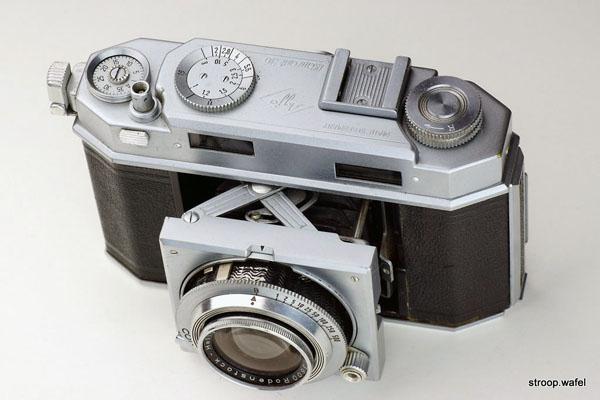
The first version of the Agfa Karat 36, here with a fast Rodenstock Heligon f/2 lens. Although most Karat 36 had a mushroom-shaped shutter release button, this particular one has a simple straight one. It is also missing a flash sync socket.
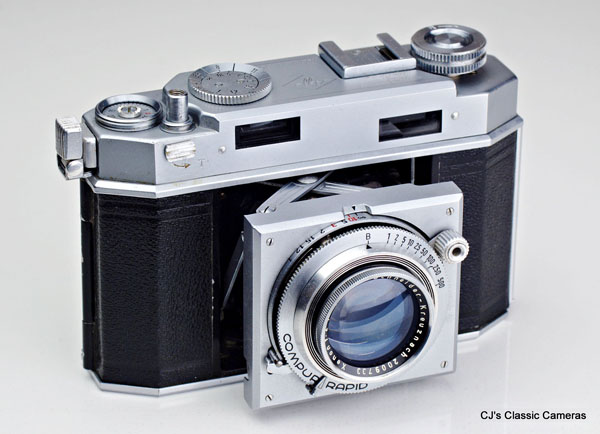
Same model with Schneider-Kreuznach Xenon f:2 F=5 cm lens. I wrote this deliberately like that, as not long after the markings on the lenses were changed to Xenon 1:2/50, so in millimetres. I didn't take the photo very well, so you'll have to take my word for it.

An unusual and perhaps unique variant of the Karat 36 is this Arat Rapido. It has a Schneider-Kreuznach Xenon lens with a 5-digit serial#, as also found on the very early production of the Karat 36 v1. However, it has an unusual serial# that does not match the Karat 36 range, or any early Karats. It's very similar to the Karat-S, another variant of which I have only ever found one example and no information anywhere.
I repaired this Rapido for a client and show it here with their permission.
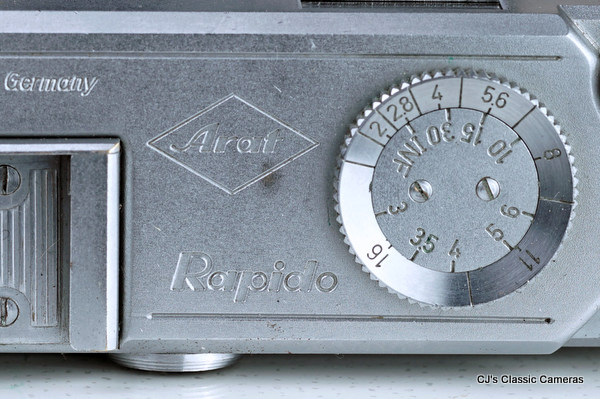
|
Top view of the Arat Rapido. The name 'Rapido' is interesting because you would think it refers to the Rapid cassettes that the Agfa Karat used, but that name wasn't actually introduced until much later. At the time the cassettes were still known as Karat cassettes.
|
Karat 36 v.2
With the second model of the Karat 36 (introduced late 1951) the foldable wind lever was replaced by a fixed one with a round knob and the frame counter was integrated in the top plate. In addition, a small film reminder window was introduced next to the rewind knob and a flash sync socket was added to the shutter assembly. This model no longer featured the T button on the front of the camera. It came with a Synchro-Compur shutter and either a Schneider Xenon or Rodenstock Heligon lens, and was also sold as Ansco Karomat (see below). Only about 6,500 pieces of this model were made, after which it was replaced by the v.3 below.

The second version of the Agfa Karat 36, here with a Schneider Xenon f/2 lens and shown with its original box.
Karat 36 v.3
The third and most common version of the Karat 36 (introduced mid 1952) had depth of field markings integrated in the lens base, so the indicator on the top plate was no longer needed. It had 'Agfa Karat 36' engraved in italics on top of the camera and no longer featured the diamond-shaped Agfa logo that had been engraved on the camera since the first model of the Karat 12. Otherwise it was very similar to the previous version. It can be found with any of the five lenses mentioned in the intro, but most commonly with Xenon, Heligon or Solinar. The Xenar made a reappearance late in its production, and the Solagon was introduced about midway, but is rare. About 58,500 v.3 were made until it was replaced by the Karat IV at the beginning of 1954.
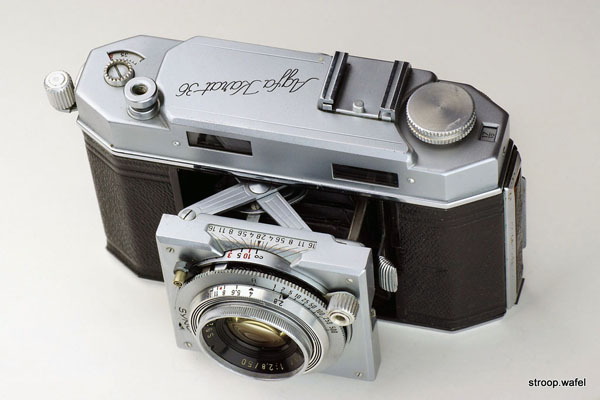
The third version of the Karat 36 with Solinar f/2.8 lens. I am not sure the rewind knob is original, as it is the only one I have ever seen without arrow and concentric grooves engraved on top.

Example of the same model but here with Rodenstock Heligon 50mm f/2 lens and an original Agfa lens cap.

Here's the rather rare Solagon 50mm f/2 version. This lens was introduced about halfway through production of this version of the Karat 36, as can be seen in the section about serial nrs at the bottom of this page, but was found on this model in quite low numbers.
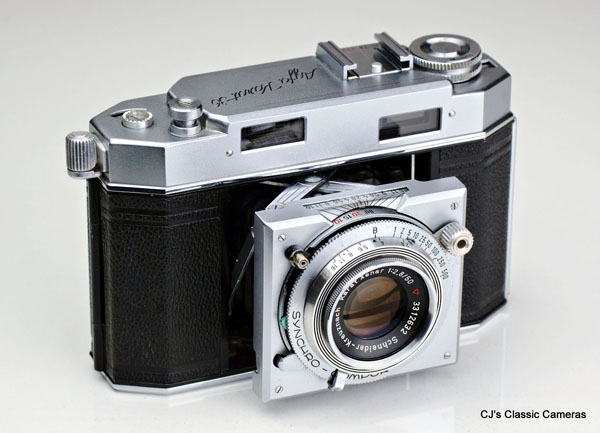
And finally, the Xenar 50mm f/2.8 version. Only a Xenon to go! But since I have the Ansco Karomat version of that model (see below) I am not that fussed.
Karomat 36
The Karomat 36 was identical to the Karat 36 v.1 and destined for export to the US. The only difference with the Karat 36 v.1 were the markings on the top plate, which said 'Karomat 36', as well as 'made by Agfa Camerawerke M nchen Germany U.S. zone' all in capitals.
This model is not to be confused with the Ansco Karomat, which were Karat 36 sold in the US rebranded as Ansco, see below.
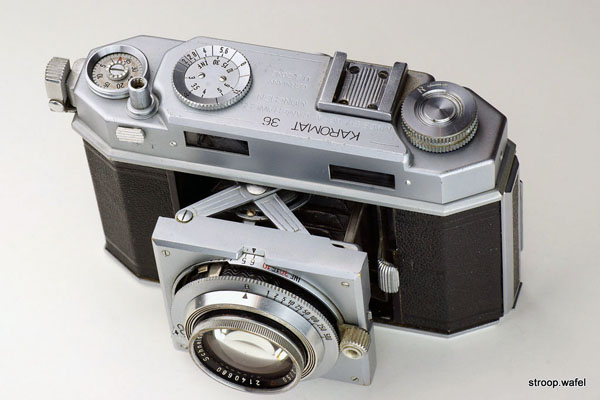
An Ansco Karomat 36 with Schneider Xenon f/2 lens.
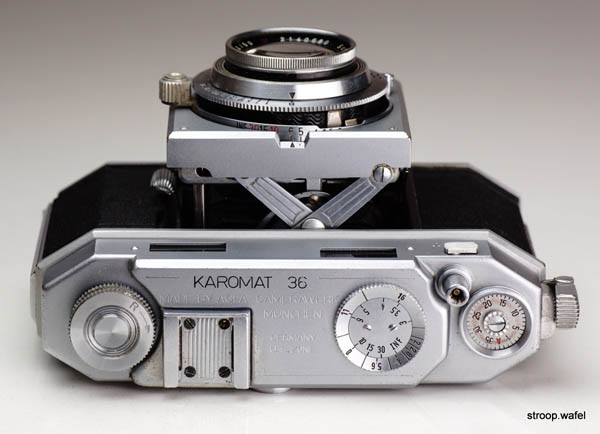
Top view of the Karomat 36.
Ansco Karomat
Not to be confused with the Karomat 36 above, the Ansco Karomat was a rebranded Karat 36. Ansco was an American photography company owned by Agfa and sold many rebranded cameras, including Minoltas such as the Uniomat (sold as Anscoset) and the Hi-Matic (sold as Autoset, famous for being taken into space by John Glen).
All three Karat 36 versions were sold as Ansco Karomat, including the first version which was initially sold as Karomat 36, the rebranding perhaps due to Agfa being associated with WWII Germany. However, the third version appears to be most common and is typically found with Schneider Xenar or Xenon lens.

An Agfa Karomat 36 with Schneider Xenon f/2 lens.
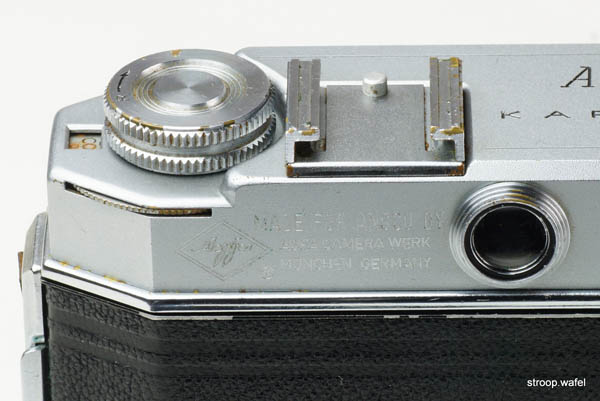
A little hard to see, but the camera carried the familiar Agfa logo and was marked 'Made for Ansco by Agfa Camera Werk Munchen, Germany.
Serial nrs. and production estimates
Like nearly all Agfa cameras, the Karats had complicated serial number systems consisting of one or two letters followed by three or four numbers. The system for the Karat 36 differed from that of the earlier Karat 2.8/12 (which themselves had two different systems). So figuring out when your Karat 36 was made based on its serial number isn't totally straightforward.
The system for the Karat 36 works as follows. Essentially, the first two letters represent batches of 500 cameras, where the first letter changed each time the second letter had gone through the whole alphabet (except the letter J, which was not used). The first letter 'counted' down from Z, and the second letter went up from A. The four-digit numbers simply counted upwards and would restart at 1001 after reaching 10,000. It appears the first body nr. was ZA 1701 (following a small batch of protoype cameras starting with KS 1501). This number would go up sequentially until ZA 2000, after which it continued with ZB 2001. Then we'd go up till ZB 2500 and continue with ZC 2501. Continuing this system we eventually get to ZR 10000, after which the cycle goes on to ZS 1001. We'll reach ZZ 5000 at some point, after which we continue with YA 5001 (so note that ZZ is not the earliest Karat 36, it is ZA instead). This system keeps repeating until after about 92,000 cameras we reach SK 5200, which is the last of the Karat 36 range. The Karat IV continued this system, starting at SL 6000, until at some point it no longer did! But that's for the Karat IV page.
There appears to be no record that link Agfa serial numbers and production dates *. However, we can estimate these from the known production dates of Schneider and Rodenstock lenses. This is shown in the figure below.
* I've recently (autumn 2023) found out there is, albeit divided into large batches of several thousand cameras. My estimate based on lens dates below appears to agree rather well.

Agfa Karat 36 production date estimates. The body serial nrs. are on the vertical axis, the date on the horizontal axis. The thick blue line gives the production date estimate, based on the lens dates and the logic that a camera must be somewhat younger than the production date of its lens. With thanks to David Jentz from the Historical Society for Retina Cameras for providing Schneider and Rodenstock production dates.
I've also included a figure of lens serial# vs. Karat body serial nr., colour-coded by Karat 36 version (and also including Karat IV). It gives an overview which lenses were used for which model, and how often.

(Click the image for the full, legible version) Agfa Karat body serial nrs. (vertical axis) vs lens serial nrs. (horizontal axis) for Schneider, Rodenstock and Agfa lenses used on the Karat 36 and IV. Note for example that the f/2.8 Agfa Solinar was introduced midway during production of the Karat 36 v.3, but was used on almost half the cameras produced from then on. The f/2 Solagon was used less often, except at the end of Karat IV production, when it was used exclusively. Rodenstock lenses were ordered in large batches, which is why they cluster together. They were often mounted on a camera much later. Also note that Xenars (green symbols) were used in small numbers only, but the early Karat 36 v.1 Xenars are missing from the plot, as these had odd five-digit serial numbers.
| 
